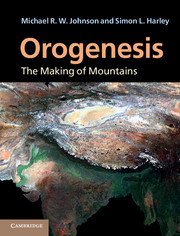Book contents
- Frontmatter
- Contents
- Preface
- Acknowledgments
- Geological timescale
- 1 Major features of the Earth and plate tectonics
- 2 Driving mechanisms for plates, slab retreat and advance, and a cause of orogenesis
- 3 Physical and chemical principles: rock deformation, isostasy, geochronology and heat production in the lithosphere
- 4 Large-scale features of orogens: thrusts and folds
- 5 Evolution of orogens
- 6 Lateral spreading of orogens: foreland propagation, channel flow and weak zones in the crust
- 7 Metamorphism in orogeny
- 8 The erosion and exhumation of mountains
- 9 Sedimentary history of the foredeep basins
- 10 Deep structure, mountain support and phase changes
- 11 Mountains and climate
- 12 Secular change in orogeny
- References
- Index
- Plate section
7 - Metamorphism in orogeny
Published online by Cambridge University Press: 05 June 2012
- Frontmatter
- Contents
- Preface
- Acknowledgments
- Geological timescale
- 1 Major features of the Earth and plate tectonics
- 2 Driving mechanisms for plates, slab retreat and advance, and a cause of orogenesis
- 3 Physical and chemical principles: rock deformation, isostasy, geochronology and heat production in the lithosphere
- 4 Large-scale features of orogens: thrusts and folds
- 5 Evolution of orogens
- 6 Lateral spreading of orogens: foreland propagation, channel flow and weak zones in the crust
- 7 Metamorphism in orogeny
- 8 The erosion and exhumation of mountains
- 9 Sedimentary history of the foredeep basins
- 10 Deep structure, mountain support and phase changes
- 11 Mountains and climate
- 12 Secular change in orogeny
- References
- Index
- Plate section
Summary
Introduction
Metamorphism is a fundamental process affecting the crust and lithosphere (Miyashiro, 1961, 1973; Ernst, 1975; Brown, 2009). Its significance for the crust is clearly demonstrated by any geological map of the continents, vast areas of which are underlain by metamorphic rocks of various types, from the slates and schists of such regions as the Alps and Appalachians to the grey gneisses of Scandinavia, Canada and Antarctica. Metamorphic rocks are those rocks produced as a result of changes in the physical conditions affecting pre-existing, or precursor, rocks at some stage of their residence in the deep Earth. Crustal protoliths, such as sediments, volcanics, intrusive igneous rocks and pre-existing metamorphic rocks, will undergo metamorphism through the operation of several processes acting on the rocks as they are subjected to changes in pressure and temperature over time, and a variety of products will result. Similarly, precursor mantle-derived ultramafic rocks will be metamorphosed in response to changes in physical conditions that accompany their incorporation in orogenic systems. The metamorphic processes affecting protoliths include mineral recrystallisation, reactions involving minerals (solid–solid reactions), reactions involving minerals and fluids (e.g. dehydration reactions) and at high temperatures reactions involving the production of partial melts and related mineral–melt interactions resulting from melt migration. Mineral dissolution and precipitation may also occur in response to the access of fluids, and those crystal-plastic processes activated by and facilitating deformation may also proceed contemporaneously with metamorphic reactions. Provided the timescale of metamorphism is long enough for equilibrium to be attained or closely approached, the mineralogies of the products will depend on the physical conditions (P, T), the presence and nature of any fluid phase, and the compositions of the protoliths. The textural features of the products will depend in a complex way on the physical conditions, mechanisms of mineral reactions, and presence and nature of fluids and melts, as well as on the timing and amount of applied stress.
- Type
- Chapter
- Information
- OrogenesisThe Making of Mountains, pp. 193 - 258Publisher: Cambridge University PressPrint publication year: 2012

